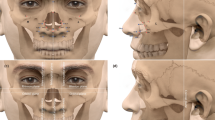Abstract
The maxilla is the key structure on facial formation and stability. The knowledge about maxillary thickness and dimensions is crucial during facial reconstruction including this bone. In this study, anthropometric measurements of anterior wall of the maxilla on the dry human skulls were aimed. Sixty maxillae of 30 adult dry skulls of West Anatolian people were evaluated. Four vertical lines were drawn between the piriform aperture and lateral border of the bone and six horizontal lines between the infra-orbital margin and the inferior border of the piriform aperture. After establishing the lines, maxillary thicknesses on the intersection points of the vertical and horizontal lines and the lengths of the vertical lines from the infra-orbital margin to alveolar arch were measured by using a fine caliper. It was found that the thickest point of the anterior wall of the maxillae is on the lateral of the infra-orbital margin (5.17 ± 2.27 mm), and thinnest one is on the inferior of the infra-orbital foramen (0.92 ± 1.06 mm). The length of the vertical line tangent to piriform aperture (47.66 ± 3.61 mm) is the longest. The corresponding data of the left and right maxillae were compared by Student’s t test. There was no significant difference between both sides. After collecting the data, a thickness map of anterior wall of the maxilla was drawn. This data may be helpful in clinic during osteotomies, bone reconstructions, screw, or other reconstruction apparatus applications on the maxilla.




Similar content being viewed by others
References
Cheung LK, Zhang Q, Wong MC, Wong LL (2003) Stability consideration for internal maxillary distractors. J Cranio Maxillofac Surg 31:142–148
Farkas LG, Tompson BD, Katic MJ, Forrest CR (2002) Differences between direct (anthropometric) and indirect (cephalometric) measurements of the skull. J Craniofac Surg 13:105–108
Farkas LG, Tompson B, Phillips JH, Katic MJ, Cornfoot ML (1999) Comparison of anthropometric and cephalometric measurements of the adult face. J Craniofac Surg 10:18–25
Greenberg AM (2002) Craniomaxillofacial reconstructive and corrective bone surgery: principles of internal fixation using AO-ASIF techniques. In: Kummer FJ (ed) Craniomaxillofacial bone healing, biomechanics, and rigid internal fixation. Springer, Berlin Heidelberg New York, pp 101–124
Gruss JS, Mackinnon SE (1986) Complex maxillary fractures: role of buttress reconstruction and immediate bone grafts. Plast Reconstr Surg 78:9–22
Manson PN (1997) The management of midfacial and frontal bone fractures. In: Georgiade GS, Riefkohl R, Levin LS (eds) Georgiade’s plastic maxillofacial and reconstructive surgery. Williams & Wilkins, Baltimore, pp 351–376
Manson PN, Clark N, Robertson B et al (1999) Subunit principles in midface fractures: the importance of sagittal buttresses, soft-tissue reductions, and sequencing treatment of segmental fractures. Plast Reconstr Surg 103:1287–1306
Satoh K, Mitsukawa N, Kadomatsu K, Tosa Y, Hosaka Y (2004) Direct skeletal traction for Le Fort I halo distraction replacing an intraoral dental splint and connecting traction hook. Ann Plast Surg 53(4):348–352
Yu JC, Fearon J, Havlik RJ, Buchman SR, Polley JW (2004) Distraction osteogenesis of the craniofacial skeleton. Plast Reconstr Surg 114(1):1E–20E
Author information
Authors and Affiliations
Corresponding author
Rights and permissions
About this article
Cite this article
Arman, C., Ergür, I., Atabey, A. et al. The thickness and the lengths of the anterior wall of adult maxilla of the West Anatolian Turkish people. Surg Radiol Anat 28, 553–558 (2006). https://doi.org/10.1007/s00276-006-0148-2
Received:
Accepted:
Published:
Issue Date:
DOI: https://doi.org/10.1007/s00276-006-0148-2




